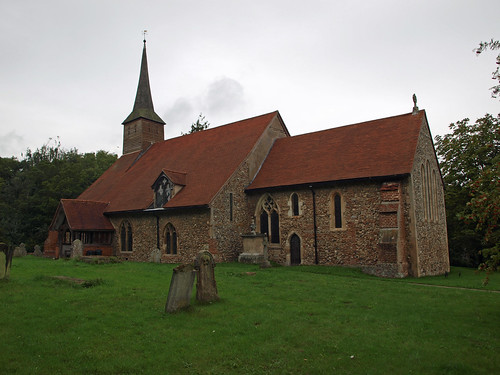St Etheldreda was locked with no sign of a keyholder, a fate shared with a string of churches in this combined parish, which is a shame as Mee makes it sound interesting. I have to admit though that the exterior left me cold.
CHURCH (Dedication unknown). Nave and aisles under one big roof. Narrower chancel. The chancel arch is the only at once visible feature of the Norman age. It is dressed with Roman bricks. To its l. and r. two round-headed niches. Traces of a Norman doorway in the S wall of the chancel can also be detected. The chancel was re-modelled in the C13, see the lancet windows so far as original. The S aisle and S arcade are of c. 1250. Circular piers and double-chamfered arches. The N aisle and N arcade a little later, with the same arches but octagonal piers. C14 S porch with plainly cusped bargeboarding. C15 belfry on four posts, with cusped arched braces on polygonal shafts high up. - FONT. Octagonal, Perp, traceried stem, bowl with quatrefoils with leaves or grotesque heads; DOOR. C14, traceried. - SCREENS. N and S aisles, E end. Both of no special interest. -chest. Big dug-out, with bevelled lid, c13? - STAINED GLASS. Upper half of the figure of a King, C13.
CHURCH (Dedication unknown). Nave and aisles under one big roof. Narrower chancel. The chancel arch is the only at once visible feature of the Norman age. It is dressed with Roman bricks. To its l. and r. two round-headed niches. Traces of a Norman doorway in the S wall of the chancel can also be detected. The chancel was re-modelled in the C13, see the lancet windows so far as original. The S aisle and S arcade are of c. 1250. Circular piers and double-chamfered arches. The N aisle and N arcade a little later, with the same arches but octagonal piers. C14 S porch with plainly cusped bargeboarding. C15 belfry on four posts, with cusped arched braces on polygonal shafts high up. - FONT. Octagonal, Perp, traceried stem, bowl with quatrefoils with leaves or grotesque heads; DOOR. C14, traceried. - SCREENS. N and S aisles, E end. Both of no special interest. -chest. Big dug-out, with bevelled lid, c13? - STAINED GLASS. Upper half of the figure of a King, C13.
The Norman masons shaped a Saxon headstone into one of their window-frames, and it has been made into a window-frame now in the vestry, with one of the rarest glass portraits in the county set in it. The portrait is of a crowned saint holding a book, a gem of colour preserved for 700 years; it has yellow fleur-de-lys as a background. The villagers are also very proud of two 16th century rondels in a modern dormer window, one showing a lovely child. The 14th century tracery in some windows is of elaborate design, and the stone faces are perhaps of local celebrities. The font is by a craftsman of the 15th century, who panelled its stem and set bearded faces, foliage, and shields on the bowl.
The oldest woodwork is a dug-out chest with a heavy lid older than Magna Carta. The door, with a traceried top, is 14th century, and so are the rafter roof of the chancel and the pent roofs of the aisles. Both aisles have traceried screens of great beauty, one 15th century and the other 16th, each only eight feet wide but with five bays. The end of the nave is filled with the massive beams set up in the 16th century to support the bell-turret, which rises without a break into a short shingled spire.
From White Notley in the persecuting days of Mary Tudor went forth its great hero George Searles, to die in the fires of martyrdom at Stratford-le-Bow. There had just been laid in the churchyard when we called a parish clerk aged 92, who was believed to be the oldest parish clerk in England, having served White Notley as clerk and sexton for 70 years. He was Joseph Challis.


No comments:
Post a Comment